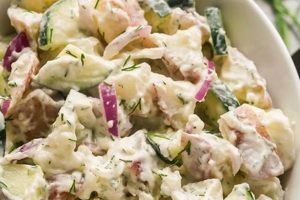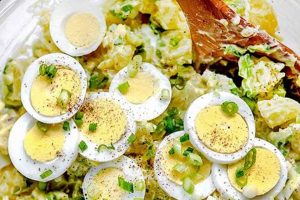This classic side dish combines cooked potatoes with a creamy dressing featuring both mayonnaise and sour cream. The addition of sour cream introduces a tangy complexity, balancing the richness of the mayonnaise and enhancing the overall flavor profile. Typical additions include hard-boiled eggs, celery, onion, and various seasonings like mustard, paprika, and dill. Numerous variations exist, incorporating ingredients such as bacon, pickles, or different types of potatoes.
The blend of mayonnaise and sour cream offers a textural advantage, creating a dressing that clings beautifully to the potatoes while remaining light and fluffy. This approach often yields a moister salad compared to those made solely with mayonnaise. The dish’s versatility makes it a popular choice for picnics, barbecues, and potlucks, offering a refreshing counterpoint to grilled meats and other summer fare. Its enduring appeal lies in its simple preparation, adaptable nature, and satisfyingly creamy texture.
Further exploration will delve into specific ingredient choices, preparation methods, and variations on this beloved culinary staple. Topics to be covered include the selection and preparation of potatoes, optimal ratios of mayonnaise and sour cream, the impact of different seasonings, and creative additions for unique flavor profiles.
Tips for Potato Salad with Sour Cream and Mayonnaise
Achieving a perfect potato salad with sour cream and mayonnaise requires attention to detail. These tips offer guidance for optimal results.
Tip 1: Potato Selection and Cooking: Opt for waxy potatoes like Yukon Gold or red potatoes, as they hold their shape well after cooking. Avoid russet potatoes, which tend to become mealy. Cook potatoes until tender but not mushy. Overcooked potatoes will result in a less desirable texture.
Tip 2: Dressing Consistency: Achieve the ideal dressing consistency by starting with equal parts mayonnaise and sour cream. Adjust the ratio based on personal preference, adding more sour cream for increased tanginess or more mayonnaise for richness.
Tip 3: Seasoning Enhancement: Elevate the flavor profile by incorporating seasonings beyond salt and pepper. Consider adding Dijon mustard, celery seed, paprika, or fresh dill.
Tip 4: Ingredient Incorporation: Add the dressing while the potatoes are still slightly warm. This allows for better absorption of flavors. Gently fold in the remaining ingredients to avoid breaking the potatoes.
Tip 5: Chilling and Serving: Allow the salad to chill for at least two hours before serving. This allows the flavors to meld and the salad to reach optimal temperature. Garnish with fresh herbs or a sprinkle of paprika before serving.
Tip 6: Customization and Creativity: Explore variations by incorporating ingredients like chopped bacon, hard-boiled eggs, crumbled blue cheese, or chopped pickles. These additions contribute texture and enhance the flavor complexity.
Tip 7: Ingredient Quality: Use high-quality mayonnaise and sour cream for the best flavor and texture. Freshly chopped herbs and spices will also enhance the overall quality of the dish.
By following these tips, one can create a potato salad with sour cream and mayonnaise that offers a harmonious balance of flavors and textures.
These guidelines provide a solid foundation for creating a delicious and satisfying potato salad. The following section will offer concluding remarks and suggestions for further exploration.
1. Potato Variety
Potato variety significantly influences the final texture and flavor of potato salad made with sour cream and mayonnaise. Selecting the appropriate potato is crucial for achieving the desired outcome. Different potato varieties possess varying starch content and moisture levels, impacting their behavior during cooking and their ultimate contribution to the salad.
- Waxy Potatoes
Waxy potatoes, such as Red Bliss and Yukon Gold, are characterized by lower starch content and higher moisture. They hold their shape well during cooking, making them ideal for potato salad. Their firm texture prevents them from becoming mushy when mixed with the creamy dressing. The smooth, creamy texture of these potatoes complements the richness of the sour cream and mayonnaise dressing.
- Starchy Potatoes
Starchy potatoes, such as Russet or Idaho, have a higher starch content and lower moisture. They tend to break down during cooking, resulting in a fluffier, drier texture. While suitable for mashed potatoes, their tendency to crumble makes them less desirable for potato salad. The high starch content can also lead to a heavier, less creamy final product.
- All-Purpose Potatoes
All-purpose potatoes, such as Kennebec, fall between waxy and starchy varieties. They offer a moderate starch content and hold their shape reasonably well during cooking. While they can be used for potato salad, they may not provide the same firm texture as waxy potatoes. This makes them a compromise, suitable but not ideal.
- Impact on Flavor and Texture
The chosen potato variety directly impacts both the flavor and texture of the salad. Waxy potatoes offer a clean, slightly sweet flavor and a creamy texture. Starchy potatoes have a more neutral flavor and a drier, fluffier texture. The right choice enhances the interplay between the potatoes and the dressing, contributing to a well-balanced and enjoyable dish. Using the wrong variety can lead to a salad that is either too mushy or too dry, detracting from the overall experience.
Careful selection of the potato variety is essential for a successful potato salad with sour cream and mayonnaise dressing. Waxy potatoes are generally preferred for their ability to hold their shape and complement the creamy dressing, creating a harmonious balance of flavor and texture. Choosing the appropriate potato ensures a salad that is both visually appealing and satisfying to the palate.
2. Sour Cream Tang
Sour cream’s tang, derived from lactic acid produced during fermentation, plays a crucial role in potato salad incorporating both sour cream and mayonnaise. This acidity provides a counterpoint to the richness of mayonnaise, preventing the overall flavor profile from becoming overly heavy or cloying. The tang also brightens the other flavors present, enhancing the contributions of ingredients such as celery, onion, and seasonings. Without the balancing acidity of sour cream, the salad could taste bland or one-dimensional. For example, in a classic potato salad recipe, the sour cream’s tang cuts through the richness of the mayonnaise and hard-boiled eggs, creating a more complex and satisfying flavor experience.
The level of tang can be adjusted based on the specific sour cream used. Different brands and varieties exhibit varying levels of acidity. Furthermore, the ratio of sour cream to mayonnaise directly impacts the final flavor profile. A higher proportion of sour cream results in a more pronounced tang, while a lower proportion allows the richness of the mayonnaise to dominate. This adjustability allows for customization based on personal preference. One might opt for a full-fat sour cream for a richer flavor and texture, or a reduced-fat version for a lighter option. Understanding the impact of sour cream selection allows for precise control over the final product.
Successfully incorporating sour cream’s tang into potato salad involves careful consideration of the overall balance of flavors. It necessitates an understanding of how the sour cream interacts with other ingredients and how its acidity contributes to the final sensory experience. Challenges can arise if the sour cream’s tang is either too subtle or too overpowering. Achieving the desired balance is key to creating a harmonious and flavorful potato salad. This balance ensures the salad is neither too bland nor too acidic, allowing the full spectrum of flavors to shine through. The interplay between the sour cream, mayonnaise, and other ingredients contributes to the dish’s overall complexity and appeal.
3. Mayonnaise Richness
Mayonnaise contributes significantly to the creamy texture and flavor profile characteristic of potato salad incorporating both sour cream and mayonnaise. Its richness, derived from oil and egg yolks, provides a luxurious mouthfeel and a base for other flavors to meld. The emulsification of oil and egg yolks creates a smooth, cohesive texture that coats the potatoes, binding them together and delivering a satisfyingly creamy consistency. This richness acts as a foundation, allowing the tang of sour cream and other seasonings to be fully appreciated without overwhelming the palate. For instance, the subtle sweetness of mayonnaise complements the savory notes of mustard and the earthy flavors of the potatoes. Without the richness of mayonnaise, the salad might lack the desired creaminess and the ability to carry the other flavors effectively. A low-fat mayonnaise, for example, may produce a thinner, less satisfying dressing that fails to adequately bind the ingredients or deliver the anticipated richness.
The quality of mayonnaise directly influences the overall quality of the potato salad. A high-quality mayonnaise, made with fresh ingredients and minimal additives, imparts a superior flavor and texture. The balance between mayonnaise and sour cream is essential; too much mayonnaise can result in an overly rich and heavy salad, while too little can lead to a dry and less cohesive dish. This balance is crucial for achieving the desired flavor profile and textural harmony. For example, a traditional potato salad often uses a 1:1 ratio of mayonnaise to sour cream, balancing the richness of the mayonnaise with the tanginess of the sour cream. Adjusting this ratio can alter the overall flavor profile, creating a tangier or richer salad depending on individual preferences.
Achieving optimal mayonnaise richness involves considering its interplay with other ingredients. The richness of mayonnaise interacts with the acidity of sour cream, the sharpness of mustard, and the flavors of any added vegetables or seasonings. This interplay creates a complex flavor profile that distinguishes a well-made potato salad. Understanding the function and impact of mayonnaise richness ensures a balanced and enjoyable final product. One challenge involves preventing the richness from becoming overpowering. Careful selection of mayonnaise and precise balancing with other ingredients, particularly sour cream, are essential for achieving the desired flavor and texture. This balance prevents the salad from being overly heavy or greasy, maintaining a refreshing quality. By understanding these principles, one can consistently create a potato salad with the ideal balance of richness, tang, and flavor complexity.
4. Complementary Ingredients
Complementary ingredients are essential for elevating a basic potato salad with sour cream and mayonnaise into a flavorful and texturally dynamic dish. These additions contribute not only to the overall taste but also to the visual appeal and perceived complexity of the salad. Careful selection and balanced incorporation of these ingredients can significantly enhance the final product.
- Aromatics
Aromatics like onions and celery provide a foundational layer of flavor. Finely diced yellow or red onion adds a pungent bite, while celery contributes a refreshing vegetal note. These elements create a savory base that complements the creamy dressing and enhances the overall complexity of the salad. The quantities of these aromatics can be adjusted to suit individual preferences, with some recipes opting for a more pronounced onion flavor while others emphasize the celery’s subtle crispness. Overpowering the salad with too much onion can detract from the other flavors, so careful balancing is crucial.
- Hard-Boiled Eggs
Hard-boiled eggs are a classic addition, offering both visual and textural contrast. The yolks contribute a creamy richness that complements the dressing, while the whites provide a firm bite. The eggs can be chopped, sliced, or quartered depending on aesthetic preference. The sulfurous notes of the yolks add a subtle depth of flavor, enhancing the overall savory profile of the salad. Properly cooked hard-boiled eggs are essential, as overcooked yolks can become dry and crumbly, detracting from the desired texture.
- Acidic Components
Incorporating an acidic element, such as dill pickles or a splash of vinegar, provides a bright counterpoint to the richness of the sour cream and mayonnaise. The acidity balances the creamy dressing and adds a refreshing tang. Dill pickles, in particular, contribute a briny flavor and satisfying crunch. The type and quantity of acidic components can be adjusted to achieve the desired level of tanginess. Excessive acidity can overwhelm the other flavors, requiring careful consideration during recipe development. Balancing acidity with the richness of the dressing is key to a successful potato salad.
- Textural Variations
Adding ingredients like chopped bacon or crumbled blue cheese introduces textural variations that enhance the eating experience. Crispy bacon provides a smoky, salty contrast to the creamy dressing and soft potatoes. Crumbled blue cheese adds a pungent, creamy element with a distinct flavor profile. These textural additions create points of interest within the salad, preventing a monotonous texture. The choice of textural elements can be customized based on personal preference, with options ranging from toasted nuts to chopped water chestnuts. The key is to use these additions judiciously, ensuring they complement rather than overwhelm the other flavors and textures present in the salad.
The strategic inclusion of complementary ingredients significantly elevates potato salad with sour cream and mayonnaise beyond a simple combination of potatoes and dressing. These additions create a more dynamic and satisfying culinary experience by introducing layers of flavor, texture, and visual appeal. The interplay between these complementary elements and the core ingredients of potatoes, sour cream, and mayonnaise determines the overall success of the dish, demonstrating the importance of careful ingredient selection and balanced incorporation.
5. Proper Cooking Technique
Proper cooking technique is paramount in achieving a successful potato salad with sour cream and mayonnaise. The texture of the potatoes significantly impacts the final dish, influencing how well they absorb the dressing and maintain their shape. Overcooked potatoes become mushy and disintegrate when mixed, while undercooked potatoes remain firm and unpleasantly starchy. Mastering the cooking process ensures a potato salad with the desired texture and flavor.
- Potato Selection and Preparation
Choosing the right potato variety is the first step. Waxy potatoes, such as Yukon Gold or red potatoes, are preferred for their ability to hold their shape after cooking. Before cooking, potatoes should be scrubbed and any blemishes removed. Uniformly sized pieces ensure even cooking. Leaving the skins on adds texture and visual appeal, but peeling is a matter of personal preference.
- Cooking Method
Boiling is the most common cooking method. Potatoes should be started in cold, salted water to ensure even cooking. The water should be brought to a boil, then reduced to a simmer. Over-boiling can cause the potatoes to break down. Testing for doneness with a fork or knife is crucial. The potatoes should be tender but not mushy, offering slight resistance when pierced.
- Cooling and Handling
Once cooked, potatoes should be drained immediately and allowed to cool slightly before adding the dressing. Adding the dressing while the potatoes are still warm allows for better absorption of flavors. However, excessively hot potatoes can cause the mayonnaise to break down. Gentle handling prevents the potatoes from being crushed, maintaining their shape and texture.
- Timing and Temperature
Precise timing and temperature control are crucial for achieving optimal potato texture. Overcooking leads to a mushy, unappetizing salad, while undercooking results in a firm, starchy texture. Monitoring the cooking process and testing for doneness regularly prevents these undesirable outcomes. The appropriate cooking time depends on the potato variety and size, typically ranging from 15 to 25 minutes.
The proper cooking technique provides the foundation for a successful potato salad. By carefully selecting and preparing the potatoes, employing the correct cooking method, cooling them appropriately, and monitoring timing and temperature, one ensures a final dish with a pleasing texture and optimal flavor absorption. These techniques contribute significantly to the overall quality and enjoyment of the potato salad with sour cream and mayonnaise, highlighting the importance of mastering this fundamental aspect of preparation.
6. Seasoning Balance
Seasoning balance is crucial for a successful potato salad recipe with sour cream and mayonnaise. It elevates the dish beyond simple ingredients, creating a complex and harmonious flavor profile. Careful consideration of seasonings complements the creamy base and other ingredients, preventing blandness and enhancing overall enjoyment.
- Salt and Pepper Foundation
Salt and freshly ground black pepper form the foundational seasoning. Salt enhances the natural flavors of the potatoes and other ingredients, while pepper adds a subtle bite. The amount of salt should be adjusted based on personal preference and the saltiness of other ingredients, such as pickles or bacon. Over-salting can easily ruin the salad, so a gradual approach is recommended, tasting and adjusting as needed.
- Mustard’s Tangy Kick
Mustard, particularly Dijon or yellow mustard, adds a tangy kick that complements the creamy dressing. Its sharpness cuts through the richness of the mayonnaise and sour cream, adding depth and complexity. The type of mustard used influences the final flavor; Dijon provides a more robust flavor than yellow mustard. The quantity should be adjusted to taste, as too much mustard can overpower the other flavors.
- Herbaceous Notes
Fresh herbs, such as dill, chives, or parsley, introduce bright, herbaceous notes. Dill pairs particularly well with potatoes and sour cream, adding a refreshing element. Chives provide a mild onion flavor, while parsley offers a clean, slightly peppery taste. Fresh herbs should be added just before serving to maintain their vibrant flavor and appearance. Dried herbs can be used as a substitute, but they should be added during the mixing process to allow them to rehydrate and release their flavors.
- Paprika’s Subtle Heat and Color
Paprika contributes a subtle heat and vibrant color. Sweet paprika adds a warm, slightly sweet flavor, while smoked paprika introduces a smoky depth. A pinch of paprika sprinkled over the finished salad enhances both its appearance and flavor. The type of paprika used can significantly influence the overall flavor profile; hot paprika should be used sparingly to avoid excessive heat.
The interplay of these seasonings creates a balanced flavor profile that elevates the potato salad. Each seasoning plays a specific role, contributing to the overall complexity and enjoyment of the dish. Careful consideration of these elements ensures a potato salad that is well-seasoned and balanced, enhancing the flavors of the potatoes, sour cream, and mayonnaise, while avoiding any single flavor from dominating. A well-seasoned potato salad offers a harmonious blend of creamy, tangy, savory, and subtly spicy notes, demonstrating the importance of seasoning balance in achieving a truly delicious final product.
7. Chilling Time
Chilling time plays a crucial role in the final quality of potato salad made with sour cream and mayonnaise. This period of refrigeration allows the flavors of the various ingredients to meld and harmonize, resulting in a more cohesive and flavorful dish. Beyond flavor development, chilling also affects the texture and overall enjoyment of the salad. The following facets explore the impact of chilling time on this classic dish.
- Flavor Development
Chilling allows the complex flavors of the potatoes, sour cream, mayonnaise, and other ingredients to fully develop and integrate. The initially distinct flavors merge over time, creating a more balanced and nuanced flavor profile. For example, the tanginess of the sour cream mellows and harmonizes with the richness of the mayonnaise, while the flavors of the seasonings permeate the potatoes. This fusion of flavors creates a more unified and satisfying taste experience compared to a freshly made salad.
- Texture Enhancement
Chilling firms the potatoes, improving their texture and making them less prone to crumbling when mixed with the dressing. This also allows the potatoes to more effectively absorb the dressing, resulting in a creamier and more cohesive salad. The chilled temperature further enhances the creamy texture of the mayonnaise and sour cream, contributing to a more enjoyable mouthfeel. A warm potato salad, conversely, may have a less appealing, somewhat greasy texture.
- Food Safety
Chilling is essential for food safety, particularly with mayonnaise-based salads. Refrigeration inhibits the growth of harmful bacteria that can cause foodborne illness. Maintaining a safe temperature below 40F (4C) is crucial for preventing bacterial proliferation. This is especially important for salads served at picnics or outdoor gatherings where temperature control can be challenging. Proper chilling protects against potential health risks associated with consuming mayonnaise-based dishes at unsafe temperatures.
- Serving Temperature
Chilling ensures the potato salad is served at the optimal temperature for enjoyment. A cold potato salad is refreshing, especially during warmer months. The chilled temperature enhances the perception of the creamy texture and the balance of flavors. Serving the salad cold also provides a pleasant contrast to other dishes that may be served warm, creating a more balanced and satisfying meal. A warm potato salad, in contrast, can taste heavy and less refreshing.
Adequate chilling time is an essential step in preparing potato salad with sour cream and mayonnaise. It contributes significantly to flavor development, texture enhancement, food safety, and optimal serving temperature. By allowing sufficient time for the flavors to meld and the salad to chill thoroughly, one ensures a more enjoyable and safer culinary experience. This seemingly simple step elevates the dish from a basic mixture of ingredients to a harmonious and satisfying culinary creation.
Frequently Asked Questions
This section addresses common inquiries regarding potato salad prepared with sour cream and mayonnaise.
Question 1: What type of potato is best suited for this type of potato salad?
Waxy potatoes, such as Yukon Gold or red potatoes, are generally preferred due to their ability to hold their shape after cooking and their creamy texture, which complements the dressing.
Question 2: Can the ratio of sour cream to mayonnaise be adjusted?
The ratio can be adjusted to suit individual preferences. Increasing the sour cream yields a tangier salad, while increasing the mayonnaise results in a richer flavor profile.
Question 3: How long should the potato salad be chilled before serving?
Chilling for at least two hours allows the flavors to meld and the salad to reach optimal temperature. Longer chilling times, up to 24 hours, can further enhance flavor development.
Question 4: What are some common additions to enhance the flavor of the salad?
Common additions include hard-boiled eggs, celery, onion, mustard, dill, paprika, bacon, and pickles. These ingredients contribute varied textures and flavors, enhancing the complexity of the dish.
Question 5: How can one prevent the potatoes from becoming mushy?
Avoiding overcooking the potatoes is crucial. Start potatoes in cold, salted water and cook until tender but not mushy. Proper cooling and gentle handling also prevent the potatoes from breaking down.
Question 6: How long can potato salad with sour cream and mayonnaise be stored in the refrigerator?
Properly stored in an airtight container, the salad should be consumed within three to five days. Spoilage signs include a sour smell, discoloration, or excessive moisture.
Careful attention to ingredient selection, preparation methods, and storage practices ensures a safe and satisfying potato salad experience.
The subsequent section offers a collection of recipe variations for further exploration.
Potato Salad Recipe with Sour Cream and Mayo
Exploration of potato salad recipes incorporating both sour cream and mayonnaise reveals a dish offering versatility and nuanced flavor profiles. Careful selection of potato variety, balanced use of mayonnaise and sour cream, and judicious incorporation of complementary ingredients are critical for achieving optimal results. Proper cooking techniques, including attention to timing and temperature, ensure desirable potato texture. A well-considered balance of seasonings further enhances the overall flavor profile. Finally, adequate chilling time allows flavors to meld and ensures food safety.
This examination underscores the potential for culinary artistry within a seemingly simple dish. Further experimentation with ingredient combinations and flavor profiles offers continued opportunities for culinary discovery and personalized enjoyment.






